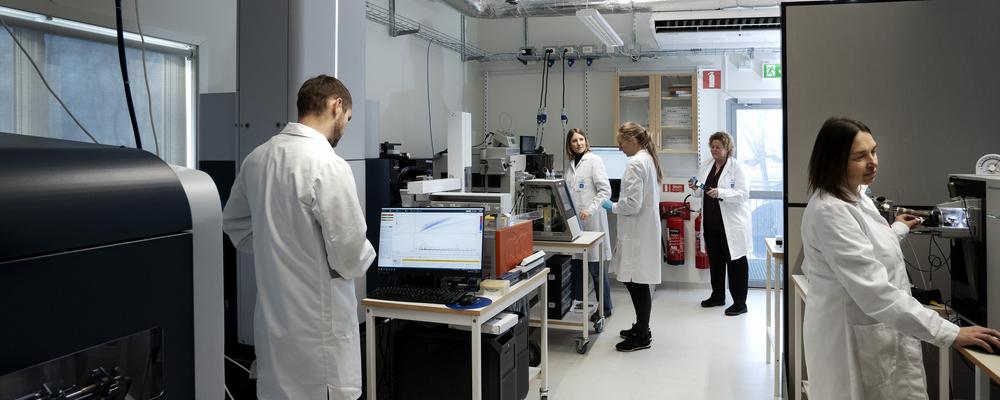
- Home
- News and events
- Find news
- Proteomics - A Field in Continuous Development
Proteomics - A Field in Continuous Development
The Proteomics Core Facility was incorporated into the Sahlgrenska Academy in 2006 and has developed from two to eight high performance mass spectrometers. Here, we get an insight into their work, why proteomics is an interesting field, and the variation of the work that they do.
Carina Sihlbom Wallem, Head of unit at Proteomics has worked at Core Facilities since 2009. Her background is in analytical chemistry and biological mass spectrometry with previous workplaces at the University of California San Francisco, NIH MS facility Tallahassee, and AstraZeneca in Mölndal.
- Our research support includes eg. method and study design, protein identification and quantification, characterization of post-translational modifications, and protein interaction analysis. The majority of projects we are involved in are discovery-based analyses, in which thousands of proteins can be identified and quantified unbiasedly, says Carina Sihlbom Wallem.
In the past few years, the field of proteomics has experienced rapid development, presenting both opportunities and challenges
- Due to the continuous progress in our field, we need to stay at the forefront of the development to possess relevant knowledge. The instruments we used fifteen years ago are outdated, and now we operate with eight modern instruments and two cutting-edge technologies.
The great difference in applications in mass spectrometry is that it also requires flexibility in handling various sample types and offering excellent service irrespective of the user's specific needs. Part of this support involves guiding users to the right techniques for their samples.
Proteomics has bought and upgraded equipment every two to three years which has made it possible for them to have a cutting-edge infrastructure. This has also resulted in Proteomics being part of national infrastructures, both SciLifeLab and BioMS.
- Being part of national infrastructures provides our team with opportunities to engage in interesting projects and build connections with colleagues throughout Sweden, extending beyond Gothenburg.
Today, Proteomics consists of a team of thirteen colleagues dedicated to different project categories, showcasing expertise in advanced proteomics, sample preparation, and MS analysis.
- Every day is different, and we have many exciting projects to work on, says team member Liisa Arike. What I appreciate the most about working at Proteomics is that it blends both scientific and engineering aspects. We get to contribute to solving different scientific questions while also spending a lot of time enhancing methods and instrumentation, she continues.
- Thanks to my team’s expertise and our infrastructure we can accept a wide range of projects which makes our day-to-day operation very varied. Lately, we have been working with failing heart biopsies and the relation to the SARS-CoV-2 receptor angiotensin as well as subtyping amyloidosis in heart biopsies. We also supported an interesting study to find out why liver transplantation causes renal dysfunction. From these type of human or animal studies, we also stretch out to toxicity studies in fish, plant analysis to find great growth conditions and even finding out the species from a piece of bone. Bacteria antibiotic resistance, glycosylation in parasites, and phosphorylation in cancer are other types of our workflows. We can do a lot from extracting proteins from biological material and matching data to the huge NCBI protein database, says Carina Sihlbom Wallem.
In March 2024, a single-cell isolation and sample preparation system, CellenONE, was installed. This happened right after the high throughput sample preparation robotic for Clinical MS analysis.
- These are examples of new strategies on the preparation side, which is a very important area. If you choose the right workflow from the start then you will get the best result from the MS instruments.
Most complex diseases for which treatment remains elusive have a multicellular aetiology, and a single cell perspective could be crucial in advancing our understanding and ability to select the most therapeutically impactful cellular or molecular targets. Clinical monitoring of disease progression and response to therapy with single cell approaches is starting to influence clinical decision-making. Single cell molecular phenotyping has already been used to understand cancer development and heterogeneity in glioma as well as microglia subtypes in neurodegenerative disease. Single cell studies have also improved the understanding of cancer metastasis, and inflammatory and autoimmune diseases. The proteome depth is now possible to achieve from single cells, adding important contributions to the understanding of cellular heterogeneity. It is critical to minimize protein losses due to the limited amount of starting material.
- At PCF we have installed the recent enhancements in trapped ion mobility spectrometry (TIMS) coupled to fast and sensitive mass spectrometry established in the timsTOF SCP and Evosep system, and we are very excited for the CellenONE platform for ultra-sensitive proteome analyses at the single cell level.